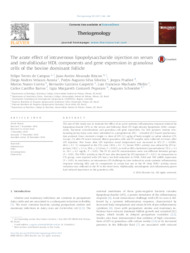The acute effect of intravenous lipopolysaccharide injection on serumand intrafollicular HDL components and gene expression in granulosacells of the bovine dominant follicle.
The acute effect of intravenous lipopolysaccharide injection on serumand intrafollicular HDL components and gene expression in granulosacells of the bovine dominant follicle.
Autoria: CAMPOS, F. T. de; RINCON, J. A. A.; ACOSTA, D. A. V.; SILVEIRA, P. A. S.; PRADIEÉ, J.; CORRÊA, M. N.; GASPERIN, B. G.; PFEIFER, L. F. M.; BARROS, C. C.; PEGORARO, L. M. C.; SCHNEIDER, A.
Resumo: The aim of this study was to evaluate the effect of an acute systemic inflammatory response induced by lipopolysaccharide (LPS) in the serum and follicular fluid (FF) high-density lipoprotein (HDL) components, hormone concentrations and granulosa cell gene expression. For this purpose, twenty non-lactating Jersey dairy cows were submitted to a progesterone (P4) ? estradiol (E2) based synchronization protocol. Cows received a single i.v. dose of LPS (2.5 μg/kg of body weight) or saline solution (CTL Group) 2 h after P4 insert removal. Blood, granulosa cells and FF samples were collected six hours after LPS injection. Five hours after LPS injection rectal temperature was increased in LPS (P < 0.0001, 40.4 ± 0.1 °C) compared to the CTL cows (38.8 ± 0.1 °C). Serum PON1 activity was reduced by LPS injection (130.2 ± 5.1 vs. 99.6 ± 3.3 U/mL; P < 0.001), as well as HDL-cholesterol concentrations (70.3 ± 5.3 vs. 50.1 ± 6.2 mg/dL; P < 0.05). The FF E2 and P4 concentrations were not different between groups (P > 0.05). The PON1 activity in the FF was also decreased by LPS injection (P = 0.01). In comparison to CTL group, cows injected with LPS had a ten fold reduction in STAR, TLR4 and TNF mRNA expression (P < 0.05). In conclusion, an intravenous LPS challenge in cows induced an acute systemic inflammatory response reducing HDL and its components in serum but not in the FF. Only PON1 activity serum reduction was reflected in the FF in the short term. Additionally, steroidogenic and inflammatory genes had reduced expression in the granulosa cells.
Ano de publicação: 2017
Tipo de publicação: Artigo de periódico
Unidade: Embrapa Rondônia
Palavras-chave: Colesterol, Esteroidogênese, Inflamação, PON1, cholesterol, inflammation, steroidogenesis
Observações
1 - Por padrão são exibidas publicações dos últimos 20 anos. Para encontrar publicações mais antigas, configure o filtro ano de publicação, colocando o ano a partir do qual você deseja encontrar publicações. O filtro está na coluna da esquerda na busca acima.
2 - Para ler algumas publicações da Embrapa (apenas as que estão em formato ePub), é necessário ter, no celular ou computador, um desses softwares gratuitos. Sistemas Android: Google Play Livros; IOS: iBooks; Windows e Linux: software Calibre.
Acesse outras publicações
Acesse a Base de Dados da Pesquisa Agropecuária (BDPA) para consultar o acervo completo das bibliotecas da Embrapa.

